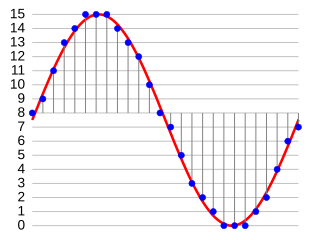A codec is a computer hardware or software component that encodes or decodes a data stream or signal. Codec is a portmanteau of coder/decoder.
MPEG-1 is a standard for lossy compression of video and audio. It is designed to compress VHS-quality raw digital video and CD audio down to about 1.5 Mbit/s without excessive quality loss, making video CDs, digital cable/satellite TV and digital audio broadcasting (DAB) practical.
Adaptive Transform Acoustic Coding (ATRAC) is a family of proprietary audio compression algorithms developed by Sony. MiniDisc was the first commercial product to incorporate ATRAC, in 1992. ATRAC allowed a relatively small disc like MiniDisc to have the same running time as CD while storing audio information with minimal perceptible loss in quality. Improvements to the codec in the form of ATRAC3, ATRAC3plus, and ATRAC Advanced Lossless followed in 1999, 2002, and 2006 respectively.
Speex is an audio compression codec specifically tuned for the reproduction of human speech and also a free software speech codec that may be used on voice over IP applications and podcasts. It is based on the code excited linear prediction speech coding algorithm. Its creators claim Speex to be free of any patent restrictions and it is licensed under the revised (3-clause) BSD license. It may be used with the Ogg container format or directly transmitted over UDP/RTP. It may also be used with the FLV container format.
Variable bitrate (VBR) is a term used in telecommunications and computing that relates to the bitrate used in sound or video encoding. As opposed to constant bitrate (CBR), VBR files vary the amount of output data per time segment. VBR allows a higher bitrate to be allocated to the more complex segments of media files while less space is allocated to less complex segments. The average of these rates can be calculated to produce an average bitrate for the file.
In telecommunications and computing, bit rate is the number of bits that are conveyed or processed per unit of time.
Continuously variable slope delta modulation is a voice coding method. It is a delta modulation with variable step size, first proposed by Greefkes and Riemens in 1970.

G.722 is an ITU-T standard 7 kHz wideband audio codec operating at 48, 56 and 64 kbit/s. It was approved by ITU-T in November 1988. Technology of the codec is based on sub-band ADPCM (SB-ADPCM). The corresponding narrow-band codec based on the same technology is G.726.
Variable-Rate Multimode Wideband (VMR-WB) is a source-controlled variable-rate multimode codec designed for robust encoding/decoding of wideband/narrowband speech. The operation of VMR-WB is controlled by speech signal characteristics and by traffic condition of the network. Depending on the traffic conditions and the desired quality of service (QoS), one of the 4 operational modes is used. All operating modes of the existing VMR-WB standard are fully compliant with cdma2000 rate-set II. VMR-WB modes 0, 1, and 2 are cdma2000 native modes with mode 0 providing the highest quality and mode 2 the lowest ADR. VMR-WB mode 3 is the AMR-WB interoperable mode operating at an ADR slightly higher than mode 0 and providing a quality equal or better than that of AMR-WB at 12.65 kbit/s when in an interoperable interconnection with AMR-WB at 12.65 kbit/s.
MPEG transport stream or simply transport stream (TS) is a standard digital container format for transmission and storage of audio, video, and Program and System Information Protocol (PSIP) data. It is used in broadcast systems such as DVB, ATSC and IPTV.
Smart Bitrate Control, commonly referred to as SBC, was a technique for achieving greatly improved video compression efficiency using the DivX 3.11 Alpha video codec or Microsoft's proprietary MPEG4v2 video codec and the Nandub video encoder. SBC relied on two main technologies to achieve this improved efficiency: Multipass encoding and Variable Keyframe Intervals (VKI). SBC ceased to be commonly used after XviD and DivX development progressed to a point where they incorporated the same features that SBC pioneered and could offer even more efficient video compression without the need for a specialized application. Files created by SBC are compatible with DivX 3.11 Alpha and can be decoded by most codecs that support ISO MPEG4 video.
In telecommunications, average bitrate (ABR) refers to the average amount of data transferred per unit of time, usually measured per second, commonly for digital music or video. An MP3 file, for example, that has an average bit rate of 128 kbit/s transfers, on average, 128,000 bits every second. It can have higher bitrate and lower bitrate parts, and the average bitrate for a certain timeframe is obtained by dividing the number of bits used during the timeframe by the number of seconds in the timeframe. Bitrate is not reliable as a standalone measure of audio or video quality, since more efficient compression methods use lower bitrates to encode material at a similar quality.

Statistical multiplexing is a type of communication link sharing, very similar to dynamic bandwidth allocation (DBA). In statistical multiplexing, a communication channel is divided into an arbitrary number of variable bitrate digital channels or data streams. The link sharing is adapted to the instantaneous traffic demands of the data streams that are transferred over each channel. This is an alternative to creating a fixed sharing of a link, such as in general time division multiplexing (TDM) and frequency division multiplexing (FDM). When performed correctly, statistical multiplexing can provide a link utilization improvement, called the statistical multiplexing gain.
Dolby Digital Plus, also known as Enhanced AC-3, is a digital audio compression scheme developed by Dolby Labs for the transport and storage of multi-channel digital audio. It is a successor to Dolby Digital (AC-3), and has a number of improvements over that codec, including support for a wider range of data rates, an increased channel count, and multi-program support, as well as additional tools (algorithms) for representing compressed data and counteracting artifacts. Whereas Dolby Digital (AC-3) supports up to five full-bandwidth audio channels at a maximum bitrate of 640 kbit/s, E-AC-3 supports up to 15 full-bandwidth audio channels at a maximum bitrate of 6.144 Mbit/s.
Internet Low Bitrate Codec (iLBC) is a royalty-free narrowband speech audio coding format and an open-source reference implementation (codec), developed by Global IP Solutions (GIPS) formerly Global IP Sound. It was formerly freeware with limitations on commercial use, but since 2011 it is available under a free software/open source license as a part of the open source WebRTC project. It is suitable for VoIP applications, streaming audio, archival and messaging. The algorithm is a version of block-independent linear predictive coding, with the choice of data frame lengths of 20 and 30 milliseconds. The encoded blocks have to be encapsulated in a suitable protocol for transport, usually the Real-time Transport Protocol (RTP).
Α video codec is software or a device that provides encoding and decoding for digital video, and which may or may not include the use of video compression and/or decompression. Most codecs are typically implementations of video coding formats.
H.120 was the first digital video compression standard. It was developed by the COST 211 European research project and published by the CCITT in 1984, with a revision in 1988 that included contributions proposed by other organizations. The video turned out not to be of adequate quality, there were few implementations, and there are no existing codecs for the format, but it provided important knowledge leading directly to its practical successors, such as H.261. The latest revision was published in March 1993.
Constrained Energy Lapped Transform (CELT) is an open, royalty-free lossy audio compression format and a free software codec with especially low algorithmic delay for use in low-latency audio communication. The algorithms are openly documented and may be used free of software patent restrictions. Development of the format was maintained by the Xiph.Org Foundation and later coordinated by the Opus working group of the Internet Engineering Task Force (IETF).

Opus is a lossy audio coding format developed by the Xiph.Org Foundation and standardized by the Internet Engineering Task Force, designed to efficiently code speech and general audio in a single format, while remaining low-latency enough for real-time interactive communication and low-complexity enough for low-end embedded processors. Opus replaces both Vorbis and Speex for new applications, and several blind listening tests have ranked it higher-quality than any other standard audio format at any given bitrate until transparency is reached, including MP3, AAC, and HE-AAC.

LDAC is a proprietary audio coding technology developed by Sony, which allows streaming high-resolution audio over Bluetooth connections at up to 990 kbps at 32 bits/96 kHz. It is used by various products, including headphones, earphones, smartphones, portable media players, active speakers, and home theaters.



